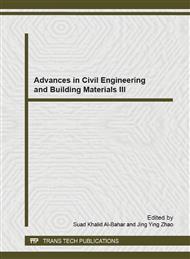p.272
p.276
p.282
p.287
p.293
p.299
p.307
p.314
p.321
Eco-Engineering Measures for the Sandy Side-Slope Protection of Newly Regulated Rivers in Humid Region
Abstract:
In humid region, the natural vegetation coverage has not restored well on the side-slope of the newly-regulated rivers before the first rainy season comes. The plants which are planted on the side-slope have also not grown enough roots to stabilize the side-slope. As a result, on the sandy side-slopes serious erosion and collapse often occurs. Thus, in order to safely ride out the first rainy season after regulation, this paper presents some ecological slope-protection measures to utilize annual ryegrass and willow branches. The experiments show that planting annual ryegrass on the sandy side-slope can effectively prevent the side-slope from eroding and safely ride out the first rainy season after regulation. Meanwhile, the restoration of native vegetation wont be hindered. If the sandy side-slope is steeper, i.e., its stability is poorer, besides planting annual ryegrass, planting willow branches-root hedges in the side-slope is also necessary. Planting willow branch-root hedges can improve the survival rate of willows and the closure of plant hedges, and thus significantly enhance the stability of sandy side-slope.
Info:
Periodical:
Pages:
293-298
Citation:
Online since:
December 2013
Authors:
Price:
Сopyright:
© 2014 Trans Tech Publications Ltd. All Rights Reserved
Share:
Citation:


